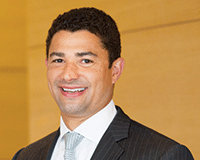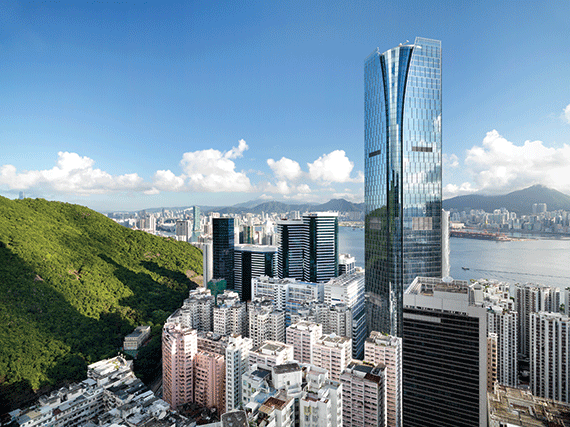Opium wars, world wars, Japanese invasion, decolonisation; the Swire Group has ridden out its fair share of market volatility over the past 199 years. The company’s long history lends an air of authority when it repeats the statement so often made by property developers, that it is all about “place making”.
The site of its largest office campus at Island East – seven metro stops from Hong Kong Central – was once occupied by the conglomerate’s sugar refinery, which in the early 1900s was the largest such facility east of the Suez canal.
Today that site is occupied by more than 8m sq ft of offices, shops, houses and a hotel across the connected TaiKoo Place and City Plaza campuses, developed by Swire’s property arm, Swire Properties. In a country and a region dominated by mixed-use development, it is both an early and an exemplary example of successful place-making in action.
To date the offices at TaiKoo Place have been occupied by back-office bank staff, telecoms companies and an assortment of other multinationals attracted by the lower rents on offer compared with Hong Kong Central.
But now Swire is getting ready to launch the next phase of development, adding two 1m sq ft office towers to what is already Hong Kong’s largest privately owned estate.
The plan is to provide premium grade-A office space complete with digital and service infrastructure unmatched elsewhere on the island, in the hope of convincing one of the major investment banks that dominate Hong Kong’s office market to move its headquarters and front office staff out of Central.
The parallels with London’s Canary Wharf and its challenge to the City are clear.
And Don Taylor, the Swire Properties director responsible for running the company’s office business, believes that, as with Canary Wharf, successful place-making will out.
Realistic
 “I think it is very realistic,” says Taylor, speaking from the marketing suite atop the 68-storey One Island East building at the heart of TaiKoo Place. He is talking about the scheme’s prospects of hooking a big investment banking fish.
“I think it is very realistic,” says Taylor, speaking from the marketing suite atop the 68-storey One Island East building at the heart of TaiKoo Place. He is talking about the scheme’s prospects of hooking a big investment banking fish.
“We are creating an environment for people who haven’t started work yet, so the banks need to think how they are going to attract and retain talent in the future. And it’s not just the workplace; it is the surrounding environment as well.”
For a city with such a photogenic skyline and massive financial services industry, Hong Kong has surprisingly little top-quality office space.
The entire city has around 90m sq ft of grade-A stock – less than half that of London. And the vacancy rate is just 4.4%, according to JLL.
“If you look at the stock in Central, probably only about 15% of it is good enough for the modern requirements of an investment bank,” says Taylor.
“The floorplates are quite small, but also the power, the chilled water, the resilience… a lot of that stock is becoming functionally obsolete.”
In addition, the density of development in the Central district means it often feels starved of open and green space, despite the luscious mountains behind it.
The effect, Taylor says, will be escalating rents for the little premium grade-A stock in Central, which will help push occupiers further afield.
Cost push, tech pull
In this context, Swire is able to offer a c50% discount on rents, compared with Central’s HK$90 per sq ft per month. Its estate boasts several acres of open space unimaginable elsewhere on the island and it will shortly benefit from a new bypass, which will cut the drive time to the airport express terminal to just six minutes.
“It’s a cost push, tech pull,” Taylor says.
But as ever with Swire, it has one eye on the much longer term.
The technology sector scarcely troubles JLL’s charts of take-up in Hong Kong, in contrast to rival financial centres such as London, New York or even Singapore, where tech occupiers have dominated in the wake of the economic crisis.
Despite this fact, Swire has decided to emulate Canary Wharf’s Level 39 facility and dedicate free floor space to start-ups.
Blueprint, the part accelerator, part co-working space, is designed both to help foster the city’s nascent tech economy and help grow some promising tenants of the future, while at the same time being beneficial to both TaiKoo Place’s existing tenant base and the Swire Group parent company’s diverse business interests.
“The ultimate goal will be for some of those start-ups, having received the mentorship from our existing tenant base, to take a tenancy directly with us,” says Taylor.
“But the beauty of TaiKoo Place is that we have a very diverse tenant base and that has really helped us, because in places like Canary Wharf it was so banking-focused that when the downturn came it was pretty exposed.”
The desire to diversify the tenant mix of the estate hints at one of those potential long-term threats which Swire has proved itself to be adept at navigating.
With the Chinese government desperate to develop Asia’s leading financial centre on the mainland, where does that leave Hong Kong’s banking-centred office market?
At present the investment banks’ Asia-Pacific HQs tend to be in Hong Kong, but as China’s capital markets continue to open up, surely pressure will mount to up sticks for the mainland?
Goldman Sachs, for example, took the decision in 2012 to base its new regional chairman, Mark Schwartz, on the mainland and not in Hong Kong, a move which at the time was compared to HSBC’s symbolic decision years earlier to base its chief executive in Hong Kong instead of London.
So does Swire, which has actively expanded its property activities onto the mainland, where it now boasts an operational portfolio of 3.2m sq ft with a further 1.2m sq ft under construction, see the rise of China’s financial sector as a threat to Hong Kong?
“It is complementary,” says Taylor. “What differentiates Hong Kong over China is rule of law and of course the financial infrastructure. If you look at the banking world, a lot of the business from China is serviced from Hong Kong.
“Hong Kong used to be described as the world’s gateway to China – actually that is now reversed. It is China’s gateway to the world and the world’s capital markets.”
It is tempting to dismiss that as wishful thinking.
But to do so would be to bet against 200 years of history.












